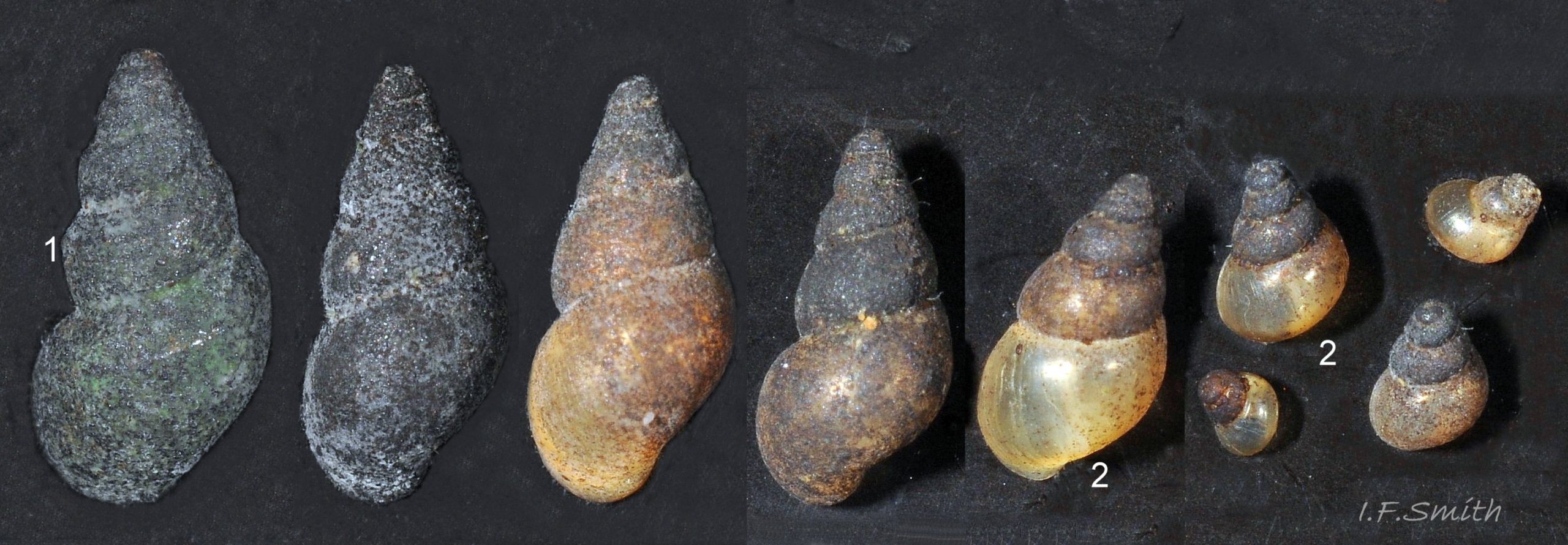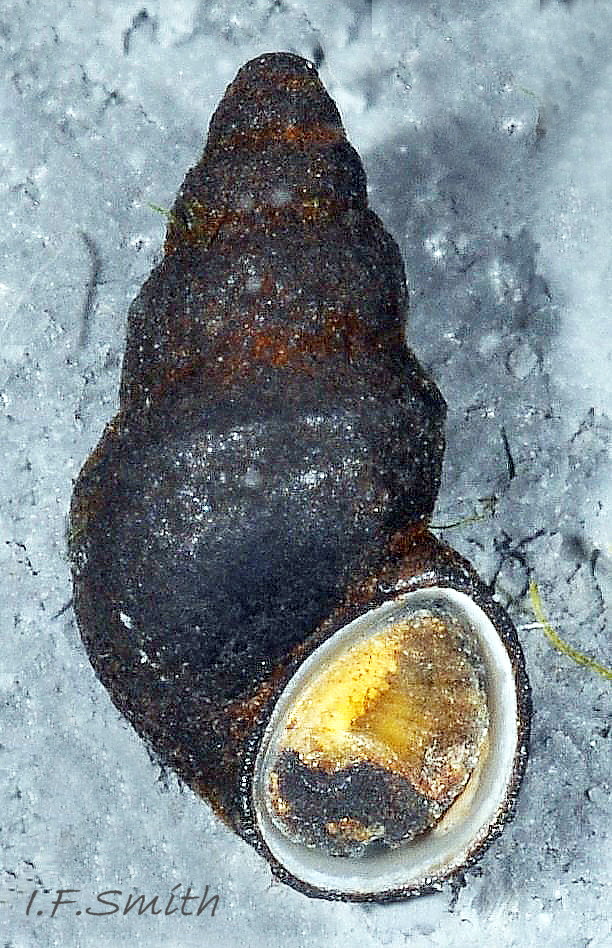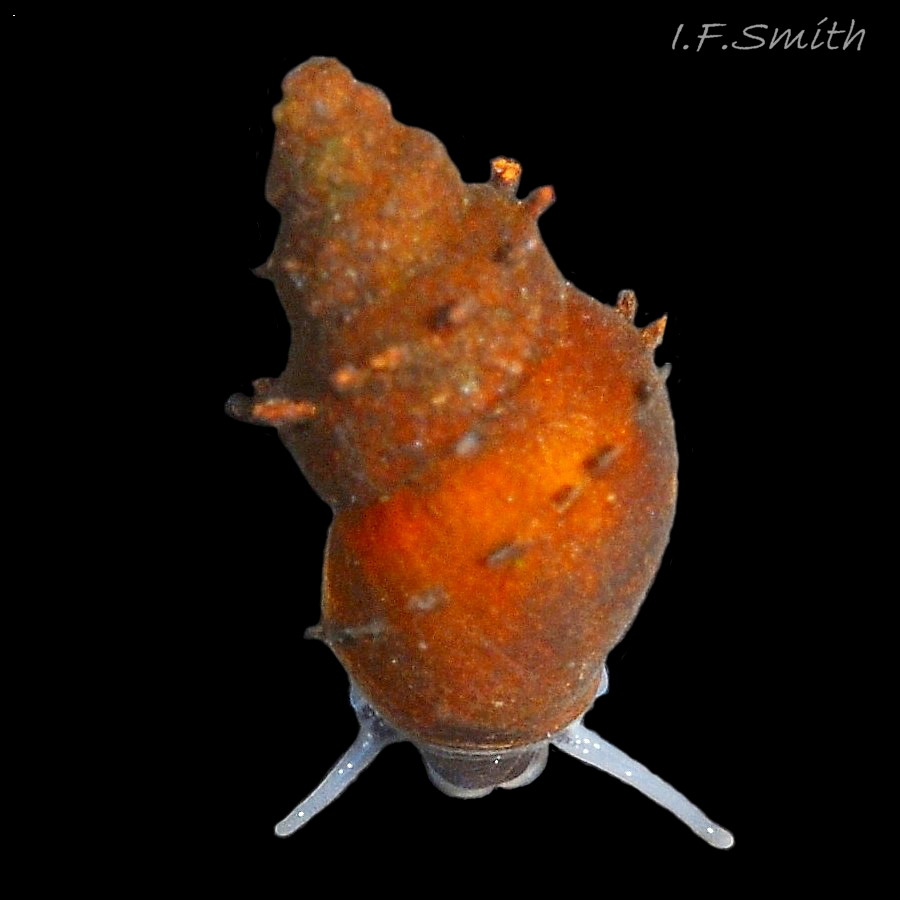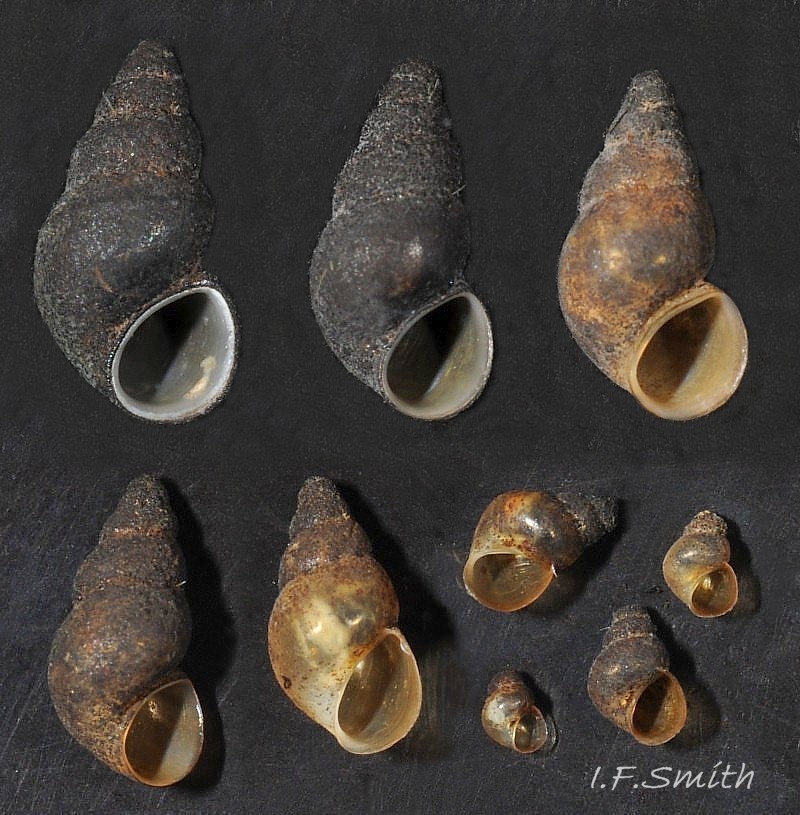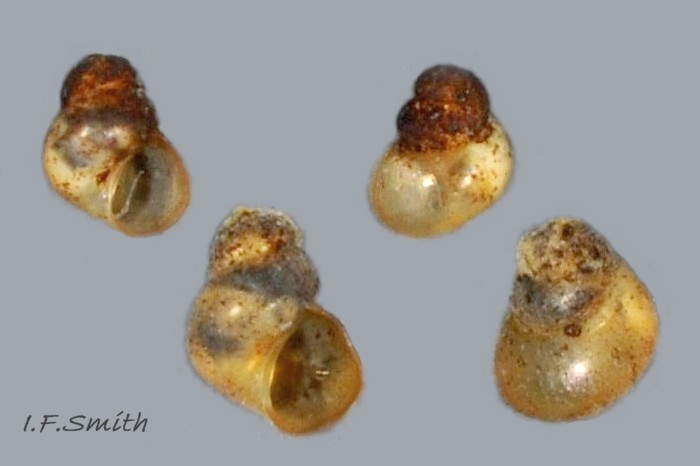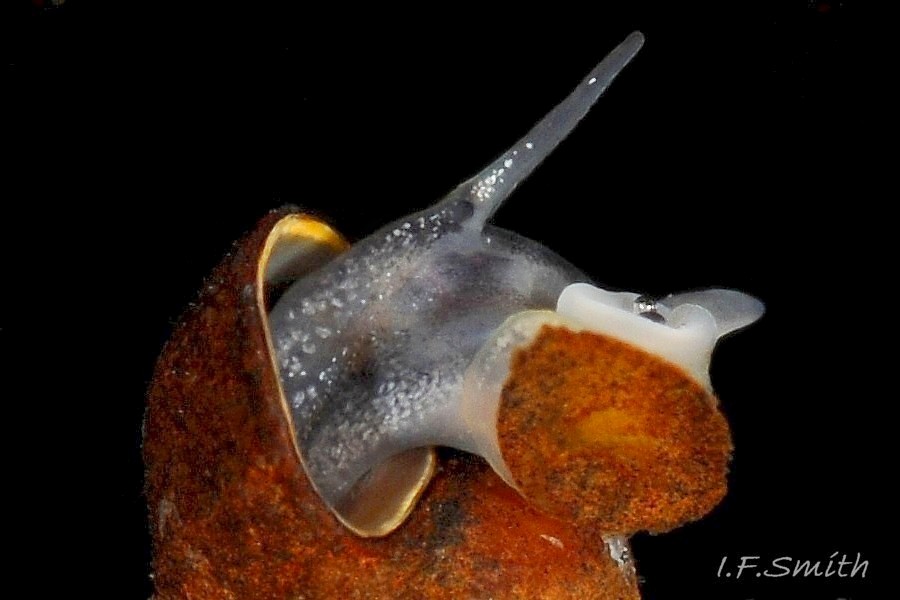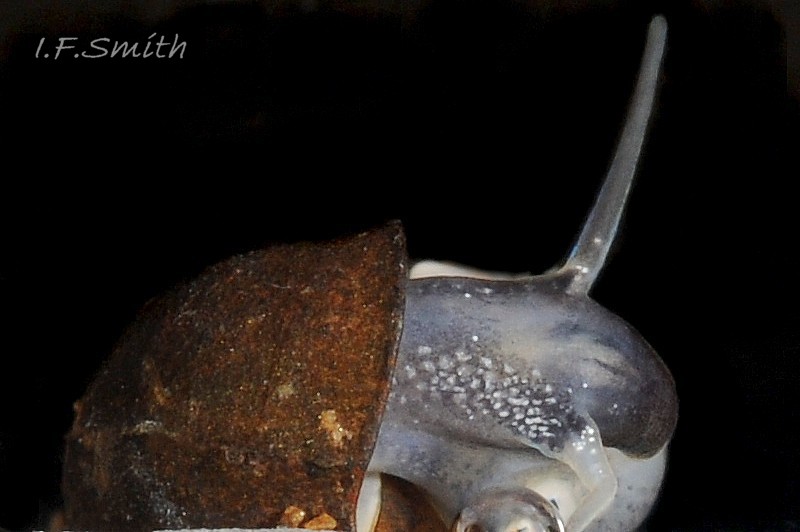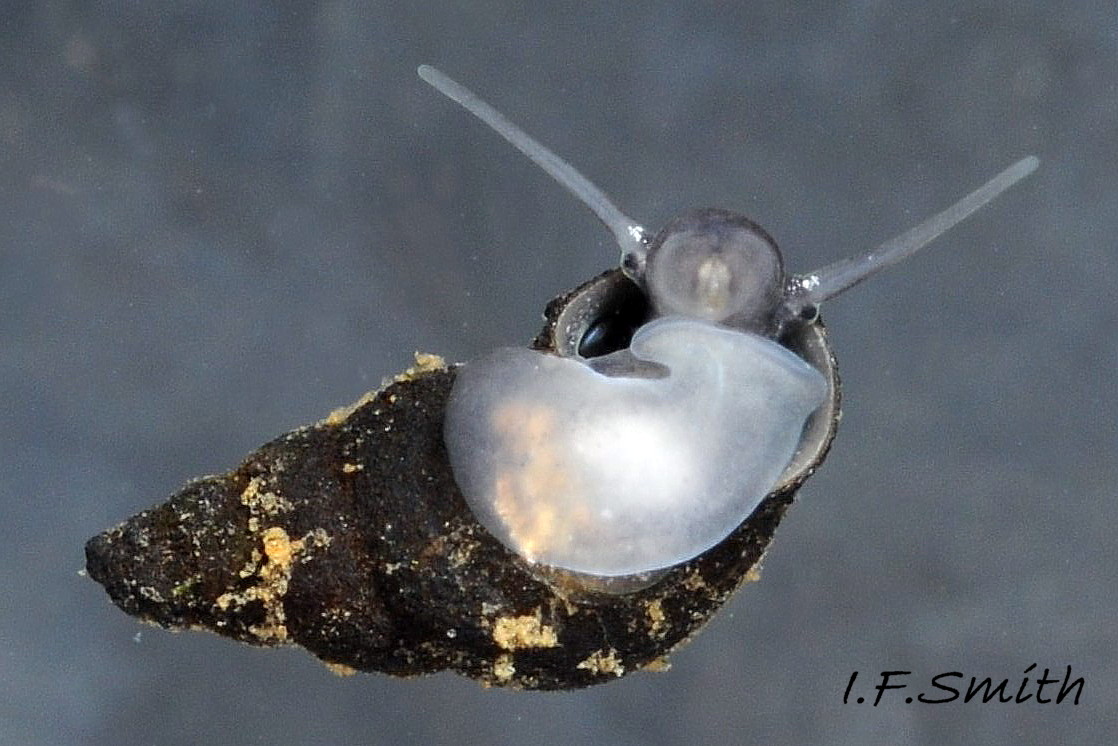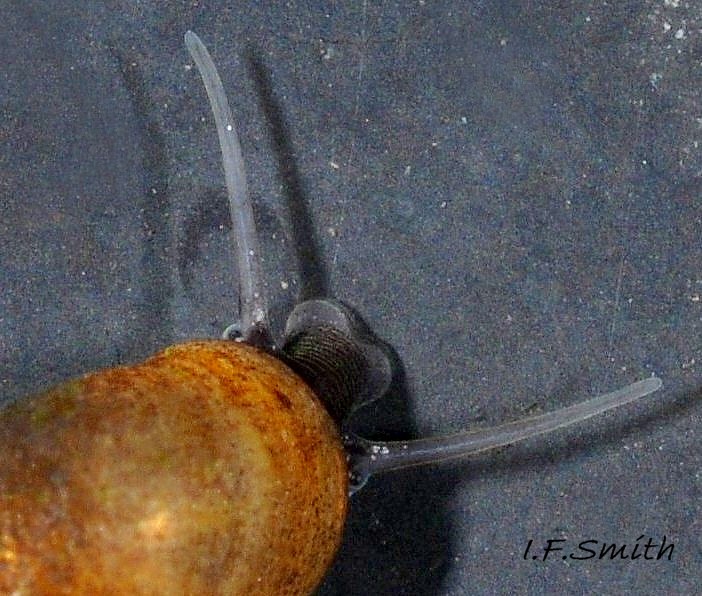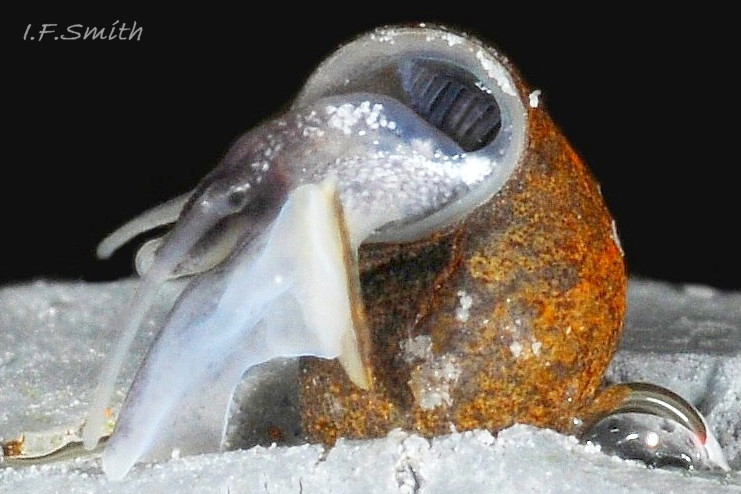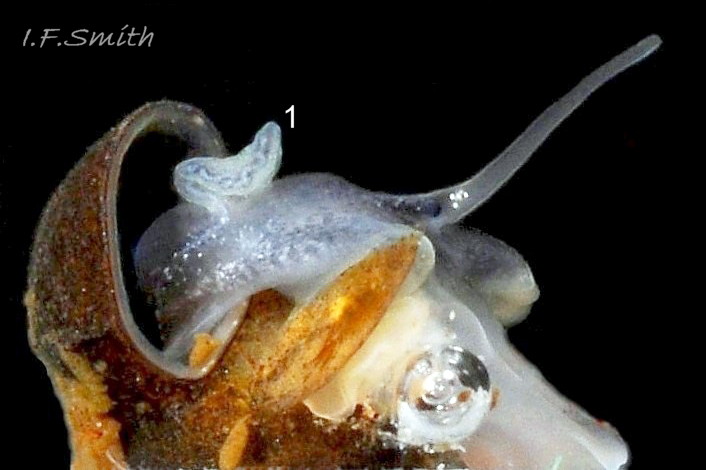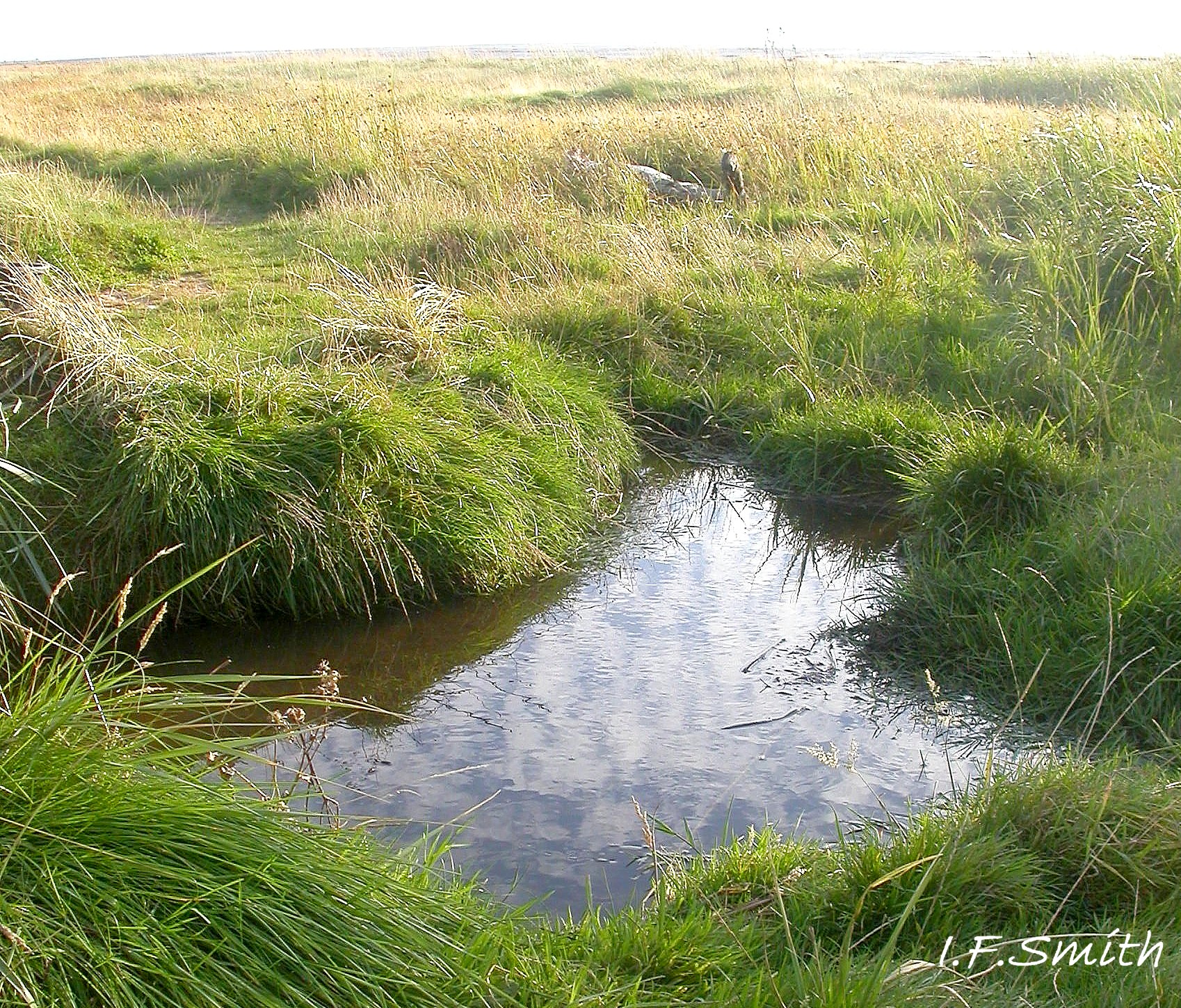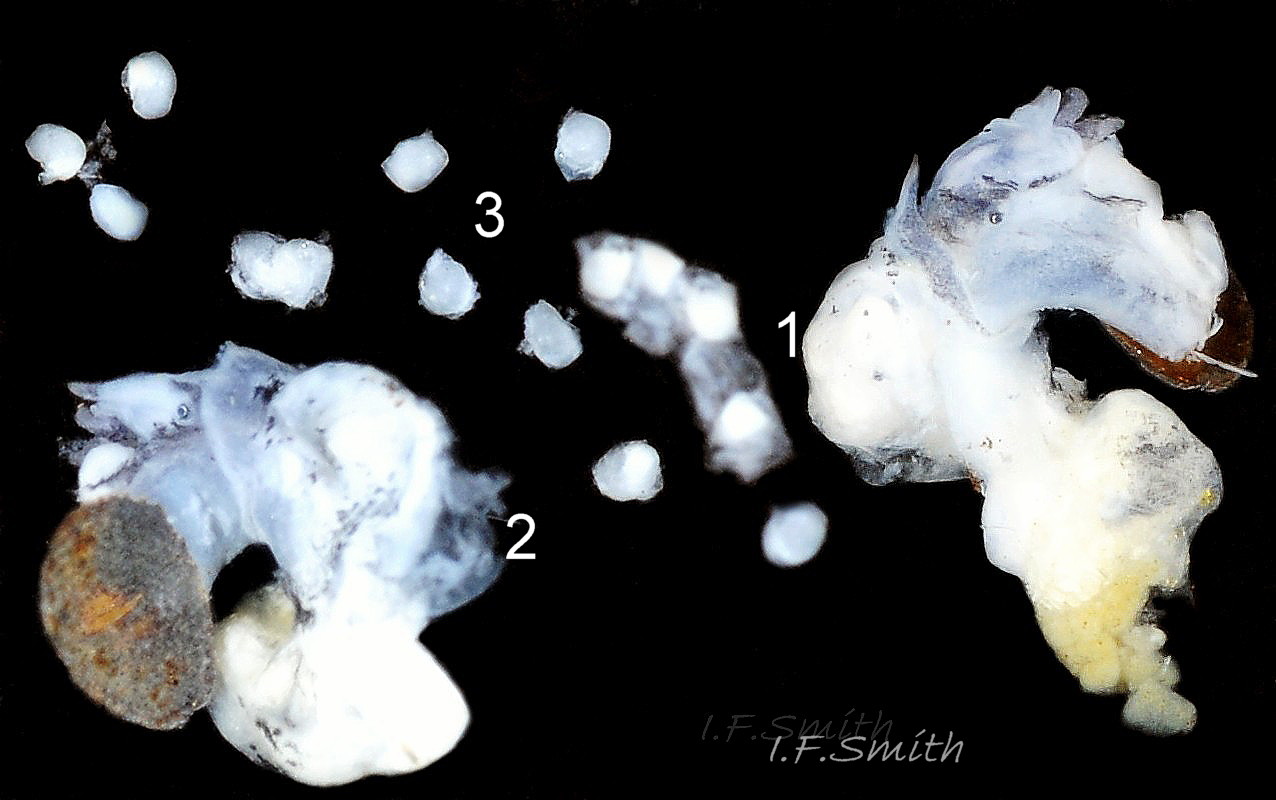Click image to enlarge with full caption. Main text below slider.
Potamopyrgus antipodarum (J.E. Gray, 1843)
Synonyms:Hydrobia jenkinsi E.A. Smith, 1889; Paludestrina jenkinsi (E.A. Smith, 1889); Potamopyrgus jenkinsi (E.A. Smith, 1889); Potamopyrgus crystallinus carinatus Marshall;
Vernacular names: New Zealand mud snail (U.S.A.); Jenkin’s spire snail;
GLOSSARY BELOW.
Shell Description
Usually up to 5mm high, sometimes 5.5mm (larger in New Zealand). Conical spire; whorls variably rounded in profile 01 Potamopyrgus antipodarum . Some have a spiral keel 02 Potamopyrgus antipodarum , and/or periostracal spines 03 Potamopyrgus antipodarum , running round all whorls which make the shell outline stouter, especially when covered by encrustations. Body whorl about 66% of 4.5mm shell height; about 70% of 2mm shell height. Only the smallest, under 2mm, usually have open umbilical chink 04 Potamopyrgus antipodarum . Shell translucent yellowish horn-colour 05 Potamopyrgus antipodarum , often only visible on most recent whorl of still growing specimens. Colour often concealed by blackish encrustation which may oxidize to rust red 03 Potamopyrgus antipodarum . Sutures variable in depth; may be obscured by encrustation. Aperture about 40% of 4.5mm shell height; about 50% of 2mm shell height. Adapical angle of aperture rounded and stands out from adjacent whorl 04 Potamopyrgus antipodarum . Aperture lip thickened on adults (shell height about 4mm and more). Smallest juveniles have slightly more acute adapical angle, and relatively large protoconch forms bulbous apex 06 Potamopyrgus antipodarum . Horny translucent oval spirally-formed operculum 02 Potamopyrgus antipodarum , pale as on white opercular lobe, unless encrusted 07 Potamopyrgus antipodarum .
Body Description
Flesh greyish white, translucent 08 Potamopyrgus antipodarum . Intensity of grey pigment varies from very pale to almost black. Anterior of foot dorsally grey. Extensive white pigment marks on sides of foot and posterior of head, with a few white marks extending to the eye 07 Potamopyrgus antipodarum . Sole translucent white 09 Potamopyrgus antipodarum. . The operculum is attached to the white opercular disc. Head has long mobile tentacles 05 Potamopyrgus antipodarum . Tentacles are translucent grey, darkest dorsally except, often, for fine faint pale medial line 10 Potamopyrgus antipodarum . Usually, very few or no white spots on tentacles apart from small area in front of eye 09 Potamopyrgus antipodarum. . No black subterminal band or mark on tentacles. Head entirely grey or black apart from pale tip on slightly bifid snout and, often, indistinct pale medial dorsal strip 11 Potamopyrgus antipodarum. . Snout is sometimes slightly wrinkled 10 Potamopyrgus antipodarum . Grey-white ctenidium has small number of sturdy leaflets 12 Potamopyrgus antipodarum. . Males, extremely rare; one examined had flexed penis with wavy white on grey vas deferens 13 Potamopyrgus antipodarum. .
Key identification features
Potamopyrgus antipodarum (J.E. Gray, 1843)
Adapical angle of shell aperture rounded 04 Potamopyrgus antipodarum .
Translucent grey tentacles often with fine white medial line, no subterminal black mark and few/no white flecks apart from basal patch in front of eye 05 Potamopyrgus antipodarum .
Primarily in flowing fresh water, but also in brackish ditches and lagoons to 17 p.p.t. salinity.
Similar species
Peringia ulvae (Pennant, 1777)
Adapical angle of aperture acute 07 Peringia ulvae .
Translucent tentacles with black subterminal band and, usually, many yellow/ white pigment flecks 11 Peringia ulvae .
Left tentacle thicker and less smooth than right tentacle 12 Peringia ulvae .
Salinity 5-40 p.p.t., usually estuarine mudflats or saltings with open tidal access.
Ecrobia ventrosa (Montagu, 1803)
www.habitas.org.uk/molluscireland/species.asp?ID=181
Adapical end of shell aperture rounded.
Tentacles lack black transverse band, but may have longitudinal dusky streak near tip.
Lagoons, no opening to sea, seawater seepage in at high tide, salinity 1-36 p.p.t., with soft substrate & vegetation.
Hydrobia acuta neglecta Muus, 1963
www.habitas.org.uk/molluscireland/species.asp?ID=94
Adapical angle of shell aperture acute.
White tentacles; tips covered with a long thin black cone except for paler extreme apex and white intrusion into cone basally.
Snout has sub-terminal black band like many H. ulvae, but rest of head black except for two whitish oval areas on snout.
Small, maximum shell height 4mm.
Lagoons, non-tidal, salinity 10-35p.p.t., sea enters by seepage through barrier, with soft substrate and vegetation.
Assiminea grayana Fleming, 1828
Adapical end of aperture pointed 01 Assiminea grayana .
Short blackish grey tentacles with eye visible dorsally near tip 08 Assiminea grayana .
Snout terminates in two broad grey or whitish lobes, head darker
06 Assiminea grayana.
Near high water mark on saltings and tidal rivers, usually moist, but not submerged except just after high spring tide or flooding.
Melarhaphe neritoides (Linnaeus, 1758)
Adapical angle of shell aperture acute 02 Melarhaphe neritoides
Usual max. height 9 mm, rarely to 10.5mm.
Periostracum brown / black-brown, sometimes with bluish bloom, usually eroded from spire 04 Melarhaphe neritoides
Periostracum extends as flexible flap beyond outer lip on many 09 Melarhaphe neritoides
Long cephalic tentacles, grey-black dorsally with thin pale median line 10 Melarhaphe neritoides
Eye centrally in large whitish disc at base of long tentacles 06 Melarhaphe neritoides
At and above EHWS on exposed rocky shores 13 Melarhaphe neritoides
Habits and ecology
Although one of the, mainly marine, Prosobranchia with usual ctenidium 12 Potamopyrgus antipodarum. and operculum 02 Potamopyrgus antipodarum , P. antipodarum lives in large and small bodies of freshwater, especially where some flow, 14 Potamopyrgus antipodarum ; also in brackish ditches and lagoons to 17 p.p.t. salinity. On stone, weed and on/in sediment, feeding on detritus. Sometimes floats under surface of water, perhaps to feed on micro-organisms in the neuston. Often at high densities. Large numbers eaten by fish, e.g. carp and trout. Eaten by birds, and dispersed adhering to mud on their beaks. Immune to most parasites that affect other British Hydrobiids.
Reproduce all year. Most populations in Britain, Europe and USA have no males, only parthenogenetic females 08 Potamopyrgus antipodarum . Males, when present, rarely exceed 2% , but up to 20% in N. W. Meirionnydd, Wales 13 Potamopyrgus antipodarum. (Wallace, 1985). Ovoviviparous, so no spawn or veliger stage; up to 40 embryos retained in brood pouch 15 Potamopyrgus antipodarum. until young snails formed and released when about 1mm shell height. Full grown at 4-5 months. Lifespan about 7 months. Only three other ovoviviparous British Prosobranchs.
Distribution and status
Fresh and brackish waters from Mediterranean to Southern Scandinavia and Baltic. Also New Zealand, temperate Australia and N. America, GBIF map www.gbif.org/species/5192470. After accidental introduction from New Zealand, spread from brackish marshes on R. Thames (1889) into freshwater (1893) throughout Britain and Ireland within 30 years, and thence to Europe. Locally abundant, to 10 000 /m² or more. Very common, except in acid upland areas. Interactive UK distribution map (NBN)
species.nbnatlas.org/species/NHMSYS0021055602
References and links
Crosier, D.M. & Molloy, D.P. 2006. New Zealand Mudsnail, Potamopyrgus antipodarum. Report for New York State Museum. https://www.fws.gov/sites/default/files/documents/Ecological-Risk-Screening-Summary-New-Zealand-Mudsnail.pdf
Fretter, V. and Graham, A. 1962. British prosobranch molluscs: their functional anatomy and ecology. London, Ray Society.
Graham, A. 1988. Molluscs: prosobranch and pyramidellid gastropods. Synopses of the British Fauna (New Series) no.2 (Second edition). Leiden, E.J.Brill/Dr. W. Backhuys. 662 pp.
Green, J. 1968. The biology of estuarine animals. London. Sidgwick & Jackson.
Wallace, C. 1986. On the distribution of the sexes of Potamopyrgus jenkinsi (Smith). J. Moll. Stud., 51, 290- 296
Glossary
aperture – mouth of gastropod shell; outlet for head and foot.
adapical – towards the apex of the shell.
bifid – divided into two parts by a cleft.
cephalic – (adj.) of the head.
ctenidium – comb-like molluscan gill; usually an axis with a row of leaflets either side.
neuston – community of micro-organisms living in the surface film of water.
operculum – horny plate, sometimes calcareous, used to close shell aperture.
ovoviviparous – (adj.) embryos develop inside egg within mother (but separated from her by persistant egg membrane). Young born from mother after, or as, eggs hatch.
p.p.t. – (salinity) parts salt per thousand parts water (brackish <30ppt).
parthenogenetic – (adj.) reproducing without fertilization by male.
protoconch – apical whorls produced during embryonic and larval stages of gastropod; often different in form from other whorls.
subterminal – a short distance from the end.
suture – groove or line where whorls adjoin.
umbilicus – cavity up axis of some gastropod shells, open as a hole or chink on base of shell, often sealed over.
umbilical chink – narrow slit opening of umbilicus on some gastropods.
vas deferens – tube carrying sperm to male’s exterior opening.
veliger – shelled larva of marine gastropod or bivalve mollusc which swims by beating cilia of a velum (bilobed flap).
